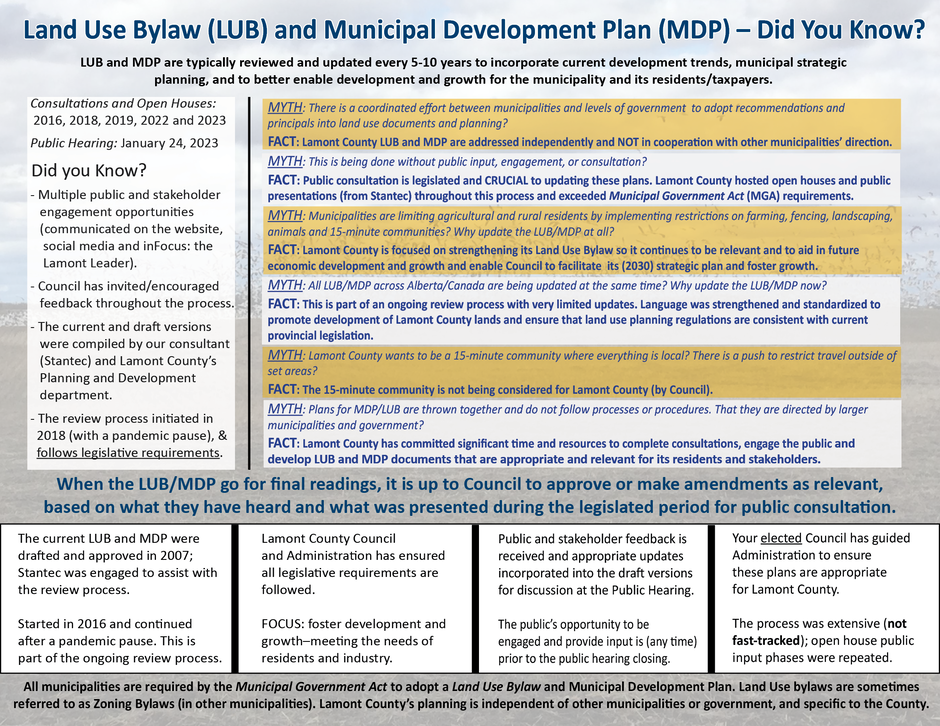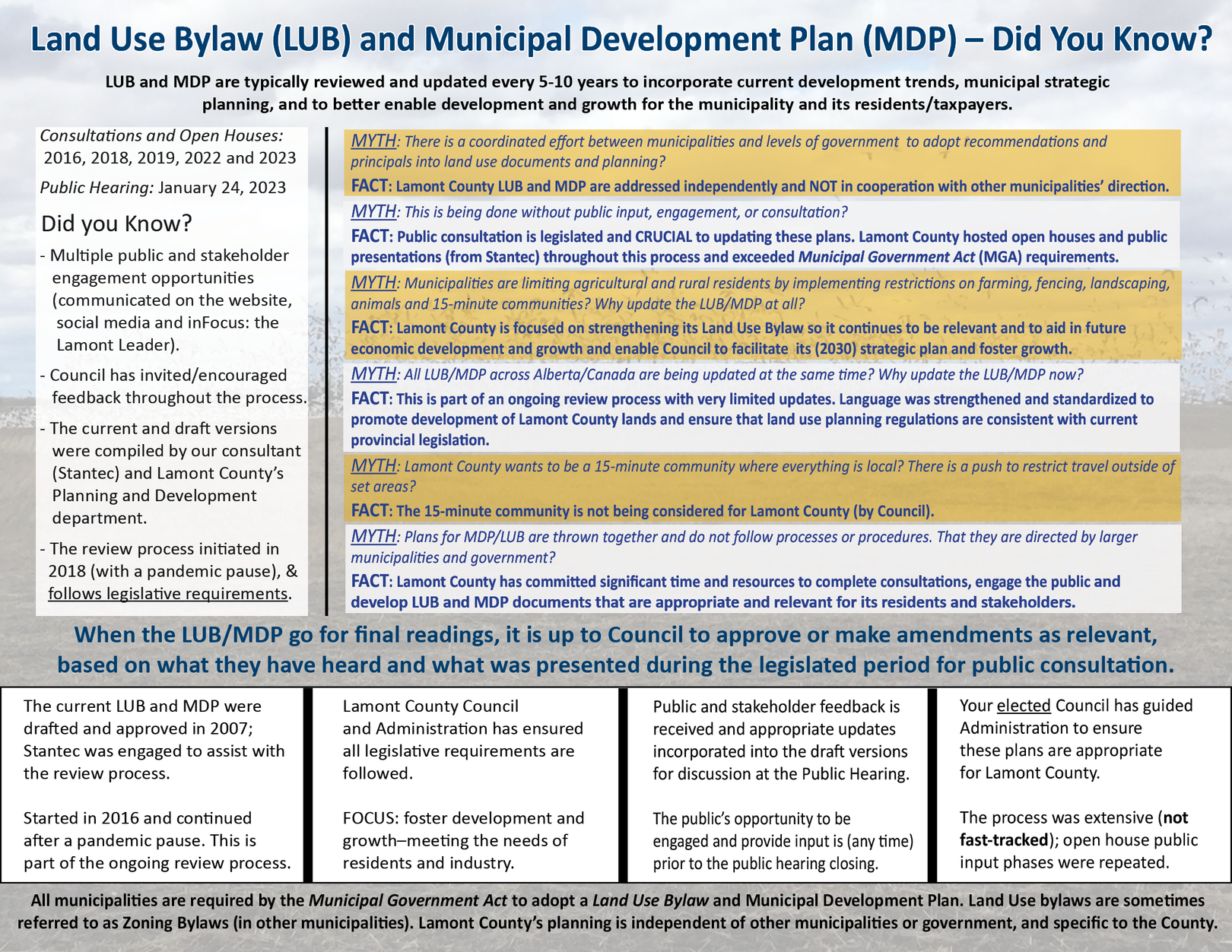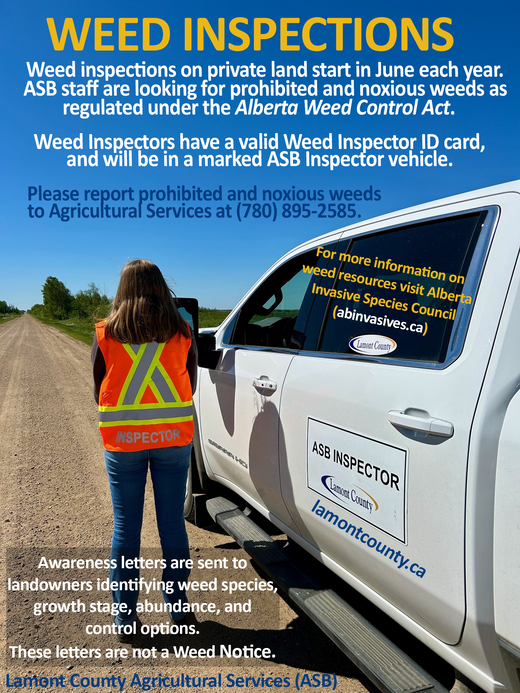Frequently Asked Questions Related to Municipal Government
If you have any questions you need clarification on, please send us a note. We will do our best to dispel rumors and clarify information that is incorrect or misleading.
Also check out online tips from the Government of Canada related to Online Disinformation: https://www.canada.ca/en/campaign/online-disinformation.html.
General Inquiry
The purposes of a Municipality (Section 3 of the Municipal Government Act) are:
(a) to provide good government;
(a.1) to foster the well-being of the environment; and
(a.2) to foster the economic development of the municipality.
(b) to provide services, facilities or other things that, in the opinion of Council, are necessary or desirable for all or a part of the municipality;
(c) to develop and maintain safe and viable communities; and
(d) to work collaboratively with neighbouring municipalities to plan, deliver and fund intermunicipal services.
Council
The Municipal Government Act outlines in Section 153 the duties of councillors, which includes promoting a strategic approach to service delivery and to participate generally in the development and evaluation of programs of the municipality.
The Chief Administrative Officer (CAO) is then charged with the duty of organizational leadership, delivery of the services mandated by Council, and overseeing and reporting on service delivery.
There is a clear division of authority as mandated and delivered.
Councillors receive input and direction from the public and bring this forward into Council Meetings for decision; input and support is also provided by the CAO and Administration as the experts hired to complete their roles and department duties. Council then makes decisions and directs Administration (the CAO) to complete these. The CAO ensures activities follow correct regulations, procedures and any impacts to the organization, and Council is responsible to weigh this information in the execution of their duties as elected officials.
Lamont County Council follows a governance model. Council is not responsible for the day-to-day activities across the County, rather, it sets the direction for the municipality.
Council makes decisions on budgets, taxation and directs Administration to complete its duties in its (typically bi-weekly) Council meetings - the public is welcome and invited to attend these meetings either in person or digitally.
Each year, Council is required to complete its budget. Budget decisions are made based on Lamont County's 2030 Strategic Plan. This plan has been created based on input from residents (either directly or through survey results and contact to Administration and Council), Council Directives, trends and developments, as well as further public engagement opportunities.
Lamont County’s Strategic Plan is “Shaping our Future”. This is because Lamont County is in a time of transition, Council has to ensure that there is an appropriate mix of long-term planning, short term successes, and appropriate staffing to execute these activities.
Lamont County Council debates and deliberates its operating and capital budget each year at its annual budget meetings (typically held in late November) with approval at the regular meeting of Council on the second Tuesday in December. These meetings include confirming and setting all projects and services based on funds available from all revenue sources, including tax dollars received from ratepayers.
The public can attend the annual budget meetings to learn more around decisions made.
A code of conduct guides how councillors carry out their roles and responsibilities. It identifies the role of councillors and what the public can reasonably expect from their councillors. It is a requirement of Sections 146.1(1), 146.1(3) and 153 of the Municipal Government Act.
A Code of Conduct is an agreed upon framework to guide the behaviour of councillors. by setting clear, concise and enforceable rules of conduct as the benchmark for behaviour and is the ruler by which alleged misconduct can be measured, acted upon and corrected. The code of conduct outlines roles and responsibilities in dealing with administration and the public.
- Lamont County 843.22 - Council Code of Conduct.
The purpose of this bylaw Is to establish standards for the ethical conduct of members relating to their roles and obligations as representatives of the municipality and a procedure for the investigation and enforcement of those standards. Councillors are expected to conduct themselves honestly, in good faith, with integrity, accountability and transparency. Councillors should conduct themselves professionally and make every effort to participate diligently in their appointed duties and roles, and in respect of the decision-making process.
Breeches of Code of Conduct can be brought forward in informal or formal proceedings. Informal discussions are typically completed in closed session. A formal complaint may involve further investigation.
Policies and Procedure
The County aims to be transparent and open. Information and individual protection of privacy are crucial in the decision-making process.
Lamont County is required to follow the Freedom of Information and Protection of Privacy Act (FOIP) legislation. However, there are exceptions in Council meetings to protect individual and confidential information.
There are exceptions to disclosure, and the following are used to protect individuals and private/privileged information. Council moves into a closed meeting for discussion and direction as related to this.
Council meetings, historically, can involve and require a commitment of closer to a 6-8 hours per meeting. Towns and villages set their own meeting agendas.
For a County, it typically is not reasonable to host these meetings in the evening (as they could run significantly later into the evening and past midnight), which is why the meetings are also recorded and shared.
The public has opportunity to review all meetings through the meeting agendas, minutes and posted video recordings. Councillors are accessible by phone and email, and through events such as coffee talks. Meeting Agendas and Recordings,
Lamont County also provides a media update to local newspapers and radio (and sometimes televisions stations) to cover what was discussed and how it affects the public; we also provide Highlights of each meeting posted at lamontcounty.ca and on social media to summarize what was discussed and approved.
Residents can attend meetings live or digitally, and can request a delegation (either in person or by written submission) with the appropriate notice to speak.
When required, public hearings are presented for opportunity to speak (and written submissions can also be submitted to be read).
Planning and Development
As a reminder, these actions and designated input periods are regulated as part of the Municipal Government Act (MGA).
These documents are required by legislation (MGA) and there are specific requirements and timelines for public notification and engagement, including public hearings and three readings before any amendments are passed in Council.
Lamont County's Municipal Development Plan and Strategic Plan, help the County to be prepared for economic opportunities and to ensure the best interests for Lamont County.
An LUB and/or MDP is typically reviewed every 5-10 years to update for current trends, government requirements and other economic updates.
Also see: lamontcounty.ca/departments/planning-development/planning-documents for the current LUB and MDP.
Governance
Both of these initiatives are legitimate processes that are reflected in legislation and available to residents to hold elected officials and municipalities accountable between elections. Across municipalities, the public can hold elected officials accountable through a petition processes. Residents have the freedom to make their own informed choices around a proposed petition and no-one should be concerned about malicious action towards anyone signing a petition.
- Recall Act (Bill 52) (Recall Act Fact Sheet)
- Municipal Inspection Reports (Municipal Inspection: Information for Petitions)
Note: these activities are initiated through the Government of Alberta ministry of Municipal Affairs (the Minister) after a petition is received. The Minister has the power to accept or reject any request (e.g., whether an inspection is warranted).
If an inspection or pre-inspection is directed by the Minister or a recall is confirmed, all costs are passed back to the Municipality (including investigation hours, confirmation of signed petitioners, byelection requirements, etc.). This can bear significant cost to a municipality.
- Municipal Affairs adopted an Inspection Cost Allocation Policy that charges costs for an inspection back to the municipality. See section 579 of the MGA.
Lamont County does work with the Government of Alberta and surrounding municipalities to work in the County's best interests and opportunities. Lamont County has to follow legislative requirements such as the Municipal Government Act and other mandated procedures.
It does not subscribe to UNESCO, WEF, Agenda 21 or 15-minute community ideas that are presented by some posts and content online.
Lamont County is focused on what is best for its residents (landowners, ratepayers, renters and other stakeholders: the public, business and industrial developments).
Lamont County does work with the Government of Alberta and surrounding municipalities to ensure opportunities and activities are in the County's best interests. It has to follow legislative requirements such as the Municipal Government Act and other mandated procedures.
It does not subscribe to UNESCO, WEF or 15-minute community ideas that are presented by some posts and content online.
Administration
The aim of Lamont County Council’s Procurement Policy 7000.24 is for consistent and fair purchasing practices and requires that staff pursue a competitive quotation process. This helps ensure an efficient allocation of available resources – essentially to buy the best product for the best price. Lamont County strictly adheres to regulations in the Municipal Government Act; the New West Partnership Trade Agreement and with procurement law.
When pursuing quotations Lamont County wants to have many bidders and for proponents to “sharpen their pencils” to provide a very competitive bid.
Each bidder has an opportunity to deliver value in a different way, provided they meet the minimum specifications. Also, a standard set of evaluation criteria is used to score the bids.
Some vendors will reduce the asking price; some will commit to a quicker delivery date; some will include extended warranty and others will charge separately for a longer warranty. Others still, will express interest in a trade-in or other options.
When recommending purchases to Council we refer to Proponent A, or B or C to protect the identify of the vendors offering unique competitive bids. The Proponent A/B/C approach prevents conflict of interest, real or perceived, and in some cases may protect the company from undue public scrutiny or embarrassment.
The content of the bids is transparent to the community – just not the identity of the bidders. This helps ensure we continue to attract many bids and get the best deal.
In a very few cases, Council has asked and Administration has provided greater detail than in the public agenda including bidder identity in Closed Session.
Procurement Policy (7000.24) was approved by Council on January 9, 2024 following a workshop with Lamont County’s legal counsel.
Lamont County Council and Administration appreciates respectful communication from its residents; abusive behaviour is not tolerated (see Respect and Patience at lamontcounty.ca/departments/communications/social-media-guidelines-lamontcounty).
Sometimes those who take matters past repeated requests and escalate to rude and/or belligerent behaviour and even harassment of staff, are subject to the Ceasing Communication(s) Policy (4202.23). This includes providing alternative means of contact or restriction to specific contact that is abusive or harassing (e.g., by letter and email vs. in person). Violating these notices may result in further action or followup, including (when relevant) RCMP followup for harassment, abuse and trespassing. These actions are taken as last resort, and at NO time is violence or abuse towards staff (verbal, physical or written) be tolerated or acceptable.
Lamont County appreciates that visitors may be frustrated at actions, a policy, changes in operation or specific service levels at any time. Residents are encouraged to contact their Councillor and/or engage in respectful dialogue with Administration when appropriate. Additionally, questions can also be raised informally at Coffee Talks, or the questions form on this page (below).
Community Services
This is done for multiple reasons, partly for awareness of cultures that are present within Lamont County, surrounding municipalities and across Alberta, Canada and the world. Some posts are also done for engagement and education of important activities that occur on a given day (including fun activities such as Pi Day or otherwise). And, depending on the event or activity, content is shared from other municipalities (including parades and community activities).
Lamont County also follows the lead of the Province (Alberta) and Canada in related posts, notifications, recognitions of cultural, historical and significant world events and activities from a respect and understanding standpoint.
The Government of Alberta also launched a multicultural calendar to recognise important dates and events across Alberta and world-wide: https://www.alberta.ca/multicultural-events.
Economic Development (and Planning)
Each town and village within Lamont County operates as a distinct organization. These organizations do work together towards common goals and benefits. However, towns and villages are responsible for its residents within the incorporation (including snow removal, road and roadside maintenance, etc.). Highways are also managed distinctly by the Government of Alberta Ministry of Transportation.
Lamont County participates collaboratively with local municipalities through the Intermunicipal Collaboration Frameworks. Intermunicipal Development Plan (IDP)'s govern development along the shared boundaries.
Economic development may occur in a town or village outside of County directions. Each organization has its own Land Use Bylaw and Municipal Development Planning. Direction is part of long-term planning and sustainability, and what is in the best interest of its residents (and planning for the future). As a reminder the Land Use Bylaw and Municipal Development Plan (and other directions and procedures) are not completed in closed door sessions and without public input. These plans are always open to public input and feedback, including presentations, open houses and in Council Meetings. These actions and designated input periods are regulated as part of the Municipal Government Act.
An important factor to tax rates and development across Lamont County is Alberta's Industrial Heartland (AIH). Development and industry in this Designated Industrial Zone (DIZ) will help reduce ratepayer taxes, and it encourages development within the region - which may include potential commercial (and retail) options, residential development and services—all of these support development and opportunities within the region (including efforts towards obtaining a water license from the North Saskatchewan Heritage River for the purposes of development/industry needs and AIH developments).
Lamont County enjoys some of the lowest taxes in the area, owing in large part to the contributions of industrial tax payers.
Economic Development is an important part of Lamont County—more information can be found at lamontcountynow.ca, as we are #ReadyforYou. #InvestInLamontCounty #RoomtoGrow
Corporate Services and Finance
Taxes are DUE June 30 each year. As a reminder, if unpaid by July 1 and January 1 there is a 10 per cent penalty applied. Lamont County Council sets the tax rate (sometimes referred to as the Mill Rate) in April each year. The rate is set to incorporate any budget modifications or updates from the approved Budget to ensure this is appropriately funded from government grants/programs, reserves and taxes received.
However, did you know that Lamont County does not receive all the tax dollars you are responsible for each year?
In fact, your tax bill includes rates that are not set by Lamont County, rather by the Government of Alberta (GOA) & the other designated requisition/expense—collected on behalf of these areas.
Your annual taxes are split between (approx. 3/4 of collection goes to Lamont County):
- Education Amounts (Alberta School Foundation) - set by the Government of Alberta.
Note: in 2025, these amounts are set to significantly increase (forecasted at an 11 per cent increase in 2025); - Seniors' Foundation Requisition (this is set annually related to the GOA Housing Act); and
- Municipal Waste Expense (this is determined annually through waste usage and is from the Waste Commission Board).
Lamont County budgets rely on tax revenues in order to provide effective and appropriate service levels for all taxpayers. These service levels are determined by Council and reviewed annually to ensure it meets County needs and budget. As many costs are passed from Government of Alberta to Municipalities (including policing costs), there are significant considerations for tax rate and use of County reserves.
If you have tax-related questions, please contact Lamont County's Tax Clerk at finance@lamontcounty.ca.
The assessor will consider the same factors that any other real estate specialist would use when determining the value of a property. Assessors can readily check assessments by making comparisons with recent sales and assessments of similar properties in the neighbourhood.
For residential properties, these factors include but not limited to:
- lot and home size
- finished basement
- construction quality
- location
- age
- upgrades
- number of bathrooms
- fireplaces
- historical and current sales prices
For multi-family (apartment) and commercial properties, these factors also include income and expense information. These types of properties are bought and sold based on the rental (lease) income they produce and therefore property owners may be requested to submit this information to the assessor.
Public Works
Gravel:
Lamont County has an annual gravelling program that identifies priority areas for resurfacing and repair. Work is typically completed during the summer months.
Snow Removal:
All County roads are maintained according to the following priority list:
During a snowfall event, the County will use the following order of priority for snow removal (connecting roads with a lower priority will also be treated for efficiency purposes).
a) Emergencies (Ambulance, Police, Fire, Utilities);
b) Major collector roads and Hamlets;
c) Bus Routes;
d) Minor collector roads;
e) Local roads (e.g., Dead End Roads, etc.);
f) Private Driveways;
g) Public Facilities as requested (churches, cemeteries, community halls);
h) Snow removal from approaches (including snow ridges that may have accumulated
on approaches); then
i) Private approaches (if not done as part of snow clearing) and unmaintained road
allowances used for agricultural purposes, on a per request basis as equipment and
resources are available.
Completion and priorities are determined in Council, as well as the rotation and vehicle/staff requirements.
Please complete a Service Request if there are roads that need attention:
https://www.lamontcounty.ca/service-requests.
Gravel road maintenance includes regular blading, gravelling, dust control and shoulder pulling activities throughout the year. This includes:
- road grading;
- shaping;
- adding material;
- removing washboards and potholes; and
- dust control.
Activities follow the graveling, snow removal, and dust control programs.
The daily traffic volume on rural roads determines the most suitable road surface—typically this can be asphalt, cold mix, dust-controlled gravel or loose gravel.
- Dust-controlled gravel roads – gravel roads that have been oiled. These roads have the appearance of a hard surface road, such as asphalt.
- Loose gravel roads – loose gravel surface with dust control near residences.
Maintenance approaches
Gravel roads are monitored and maintained as needed from April to September; and based on the condition of the road, different techniques will be used to maintain a suitable road surface for safe travel, including re-gravelling, blading or reshaping. If you experience road issues, please complete a service request (lamontcounty.ca/service-requests).
Depending on traffic volumes and the weather, as well as the gravelling program, rural gravel roads are maintained and graded throughout the summer to address wash boarding and rutting. The gravelling program is completed on a multi-year cycle.
Depending on the road type and condition, construction could also include:
- Re-gravelling;
- Blading;
- Reshaping;
- Culvert repairs and minor ditching work; and
- Road base repairs or reconstruction and reshaping.
Each summer, as part of the dust control program, identified rural gravel roads are typically treated with calcium chloride or another similar product for dust suppression.
NOTE: Alberta winters are hard on all roads, and every type of road surface requires regular maintenance. We are continually monitoring and addressing issues on all rural roads as needed, with a focus on safety, sustainability and allocation of resources.
Highways
Alberta Transportation is responsible for maintenance, construction, and snow removal on Highways.
Rail Crossings
Complaints about train noise, whistles, general property maintenance, or blocked crossings, should be directed to the CN Public Inquiry Line. CN will record, log and act on the complaint.
Emergencies or operational problems with grade crossing warning systems (lights, bells, gates), suspicious activities, trespassing on tracks, or unlawful activity, should be directed to the CN Police. An officer will be dispatched when appropriate
Lamont County monitors and maintains all rural roads on an annual basis to maintain quality roadways that enable safe travel.
The four primary causes of washboarding (corrugation of roads) are:
1. Driving habits (speed);
2. Lack of moisture;
3. Poor gravel quality; and
4. Lack of crown on the road surface.
Lamont County uses appropriate gravel for its roads and works year-round to mitigate washboarding.
To prevent the rippling/washboarding, please maintain proper speed for the road conditions. Dry weather and crowning road profiles also impacts road condition.
Please complete a Service Request if there are roads that need attention:
Emergency Services and Enforcement
When conditions warrant (dry weather, winds, wildfires, etc.), Lamont County updates to three distinct fire status:
1. Fire Advisory
During a Fire Advisory, there are no restrictions during this time. Individuals will need to apply for a permit for all open-air burning as per policy. Extreme caution for off-road vehicles, fireworks and exploding targets should be used. Campfires, charcoal barbecues, burn barrels, propane fueled fire pits are permitted.
2. Fire Restriction
During a Fire Restriction, active fire permits are rescinded, and no new fire permits will be issued. Fireworks and exploding targets are prohibited until further notice. Campfires, charcoal barbecues, burn barrels, propane fueled fire pits are permitted.
3. Fire Ban
During a Fire Ban, campfires, fireworks, exploding targets, charcoal barbeques, burn barrels, fires that require a fire permit, and any other type of outside burning are prohibited until further notice. Propane barbeques and ULC approved propane fueled fire pits are permitted.
Off-Highway Restriction during a Fire Ban: No person shall operate an Off-Highway Vehicle on Municipal Property, Highway, Permitted Use Area, or trail in Lamont County during a Fire Ban and Off-Highway Vehicle Restriction.
A person who sets a fire during this ban may be prosecuted and will be responsible for the costs of extinguishing the fire pursuant to Lamont County Regional Fire Services Bylaw 847.22 For information, please contact Lamont County, (780) 895-2233.
BRUSH PILE/DEMOLISHED BUILDING PERMITS expire February 28/29 each year. As per County Policy, there is no brush pile burning between March 1 and October 31.
BURN PERMITS are also not issued between Dec. 23 and Jan. 2 as per Lamont County Policy #4121.
Burning and permits are not allowed from December 23 through January 2 inclusive.
If a fire is proven to started off landowner property the landowner would not be responsible for the billing—unless the landowner was the cause of the fire, for example, through burning weeds, welding, open burning, etc. Only fires that can be directly attributed to a place and source of ignition are billed to a landowner.
If a fire moves from one location or landowner to a neighboring property, the Bylaw states: Section 91. (a) the person or persons causing or contributing to the fire; or owner or occupant of the parcel of land. This would also apply to renters on landowner property.
The Bylaw is available on Documents, Policies and Bylaws: Lamont County.
At the March 11 (2025) Council Meeting, Council responded to feedback from the public at a recent public meeting to immediately reinstate a $10,000 cap on firefighting cost recovery for not-at-fault fires. Council passed third reading of the Fire Services Bylaw (880.24) to make sure landowners are protected. Passing this bylaw means Lamont County landowners have a maximum $10,000 billing for emergency services response for fires that are unintentional.
Landowners are responsible for the full costs of fires that are unpermitted, not in accordance with permits, criminal in nature or as a result of negligence, including all mutual aid response costs. Residents of Towns and Villages within Lamont County remain responsible for fire response per the Regional Fire Service Agreements.
Passing this cap is the first step to ensure residents are protected from higher bills. Council has also committed to holding a workshop on March 21 to discuss options raised at the public meeting to analyze possible amendments to the Fire Bylaw that may include setting a flat fee per parcel; occupied parcel; or adjusting the tax rates to recover all firefighting costs from all Lamont County ratepayers. Once determined, Council can consider amendments to the current bylaw at an upcoming Council Meeting.
An important matter that residents should consider is limiting potential costs by examining their current insurance and researching other providers to see what peace of mind coverage is available to further lessen the risk of potential fire costs. As a reminder, if a fire is determined to not have started on a landowner’s property, they are not billed for the fire response.
Agriculture Services and Ag. Service Board (ASB)
From June 1 to Aug. 31, herbicide for brush & noxious weed control is applied in Lamont County by trained & licensed applicators using a marked spray truck. Applicators will not spray adjacent to maintained yard sites. Questions/concerns, contact Ag. Services at (780) 895-2585 or Cortex at 587-785-0483.
Lamont County ensures paved and gravelled roadsides are mowed to improve visibility and to control undesired vegetation or regulated weeds.
Brushing and mulching are conducted in County-owned ditches and roadsides in parts of rural Lamont County as part of the vegetation management program. Ornamental trees near approaches and shelterbelts on private property are not removed as part of this program.
Brushing involves removing trees along the roadside. Mulching uses a machine to shred trees and brush into mulch chips that are left to naturally decompose in the ditch over time.
If you have concerns that a roadside near you is being neglected or vegetation is becoming a hazard, please contact Ag Services at 780-895-2585.
Please complete a Service Request if there are road related, garbage, signage or other concerns that need attention:
https://www.lamontcounty.ca/service-requests.
Railway Weed Management
Updated schedules for CN rail weed management can be found on the CN Rail website.
Highway Maintenance
Highway mowing is completed by the Government of Alberta (Alberta Transportation: 780-963-5711) and Emcon Services Inc. (1-800-390-2242): https://www.alberta.ca/highway-maintenance.
Weed inspections commence in June each year. Agricultural Services staff (weed inspectors) look for prohibited and noxious weeds. This is regulated under the Alberta Weed Control Act. Inspectors are authorized to enter private property for the purposes of inspection.
Please see abinvasives.ca and lamontcounty.ca/weeds.
Please report prohibited and noxious weeds to Ag. Services at 780-895-2585.
Report any signs and sightings to Lamont County Ag. Services at 780-895-2585 and see abinvasives.ca/ squeal-on-pigs/.
It is important not to hunt feral pigs, as they are intelligent and it makes it more difficult to trap and remove. Hunting is NOT an effective option.
Boars can be farmed in Alberta as livestock, but are not native to the province. When not being raised on a farm, these wild animals are “at large” and considered an invasive species. They are declared a pest under the Pest Control Act.
Wild boars can damage property, crops, pastures and the environment, as well as be a danger to people and animals (sharp tusks), harass livestock, spread disease, and destroy habitats; they are an omnivore that eats almost any organic matter—including other animals.
Signs to watch for:
• Tracks in the snow or mud;
• Signs of digging or rolling around;
• Boars eating livestock feed; and
• Boar droppings.
If you see a wild boar at-large call 310-FARM (3276) or email af.wildboar@gov.ab.ca note the location and safely provide any photos of damage caused by wild boar or the animals themselves. Provincial government staff will collect the information and work with the landowner and the municipality to help find a solution (hunting is not a solution).



 Click to view a larger version
Click to view a larger version
